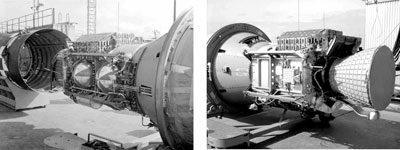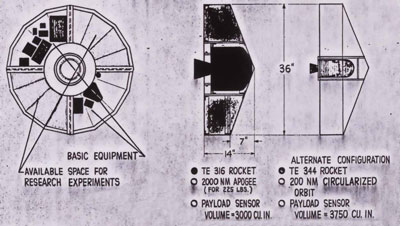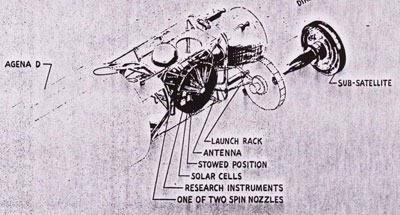Robotic ravens: American ferret satellite operations during the Cold Warby Dwayne Day
|
| “Harris took an interest in our small elint receiver,” de Broekert remembered. Then Harris asked him a question: “Do you think you can put that on a satellite?” |
Fortunately for de Broekert and his sponsor, the National Reconnaissance Office (NRO), the students never got into the safe or exposed his research. If they had, it would have been a serious blow to national security, equivalent or greater to the damage that a Soviet spy could accomplish. For what de Broekert did at SEL was design signals intelligence receivers for top secret NRO satellites, receivers that could detect the faint electronic whisper of Soviet anti-ballistic missile radars hundreds of kilometers away. The NRO quickly moved the contents of de Broekert’s safe to a more secure location. But soon after the April occupation of the lab, the protests at Stanford became more violent. Only a few months later the sounds of breaking glass were replaced by the sounds of exploding tear-gas canisters. Students set fire to the university president’s office and occupied a faculty building, and in October 1969 the president of the university capitulated to the students, closed the lab and fired all of its faculty, staff, and graduate students. De Broekert and his classified research had to move somewhere else. Their job was too important to abandon.
 A small subsatellite mounted to the aft rack of the Agena upper stage. Numerous small ferret satellites were launched in this manner. (credit: USAF) |
Dangerous provocations
During the Cold War American aircraft regularly probed the periphery of the Soviet Union. Packed with electronic detection and recording equipment manned by specialists known as “ravens,” these aircraft were charged with the mission of gathering intelligence on Soviet electronic emissions, primarily radars. The location and capabilities of Soviet radars were of vital importance to the Air Force’s Strategic Air Command, because its B-52 bombers would have to avoid or jam those radars in the event of a nuclear war. The data they collected was signals intelligence, or “sigint” for short.
The aircraft themselves were called ferrets, a name that stemmed from their mission of burrowing for prey, like their furry namesake. Rarely did the aircraft actually penetrate Soviet airspace, and those that did occasionally got shot down. But their reason for being in the air was to record signals and they could not do this if the Soviets never turned their radars on, so it was common for them to fly provocatively. Sometimes they headed directly toward the Soviet border and turned away at the last minute; sometimes they operated with other aircraft, to scare their prey by implying that they were about to do something warlike. Nobody said that being a raven was a safe job.
James de Broekert was an electrical engineer and had gone to the Stanford Applied Electronics Laboratory in the late 1950s in order to continue his education. He had previously worked on designing radar displays for the F-100 fighter aircraft. At Stanford one of his first jobs was converting electronic receivers that used vacuum tubes to transistorized solid-state technology. The work had broad applications, for many of the Air Force’s satellites would benefit by using more robust and less power-hungry solid-state components.
De Broekert and his colleagues soon developed a small handheld battery-powered electronic intelligence, or “elint” receiver. He regularly attended Technical Advisory Committee (TAC) meetings where government agencies and contractors involved in electronics intelligence systems met to discuss their work. In an August 1959 meeting he met Dr. William Harris. “Harris visited SEL during this TAC meeting, and saw the small battery-powered receiver we engineered,” de Broekert explained. “We took a subsequent pocket-sized version of that receiver on airline flights and held it up to the window, logging radar signals as we flew. Harris took an interest in our small elint receiver,” de Broekert remembered. Then Harris asked him a question: “Do you think you can put that on a satellite?”
 A diagram of a ferret spacecraft. |
Program 11
The Air Force had started formal work on a reconnaissance satellite in 1956 as part of Weapons System 117L (WS-117L). WS-117L included both visual payloads and signals intelligence payloads.
Although almost no technical information has been released concerning the early American signals intelligence satellites, some information has been declassified concerning satellites proposed in the early years of WS-117L. In 1956 electronics company RCA produced an outline of a satellite development plan indicating that their proposed ferret satellites would monitor the radio spectrum from 40 megahertz to 40 gigahertz. The proposal also included a notional illustration of a ferret satellite that looked like something out of a later James Bond film. With its nose pointed toward the earth, the satellite payload fairing peeled back like the petals of a flower, each petal sprouting a dish antenna.
Martin Co. had also proposed a reconnaissance satellite consisting of separate visual and ferret versions. The ferret versions were considerably heavier than their visual counterparts, and required more power. This was not that unusual, for at the time, signals intelligence equipment for ferret aircraft was big, heavy, and used a lot of power. Neither RCA nor Martin actually gained contracts to build reconnaissance satellites. Those contracts were instead awarded to Lockheed. But it seems likely that the ferret satellites that Lockheed had underway in the late 1950s were similarly big, heavy, and power hungry.
By 1959 the Air Force’s WS-117L program had been renamed Samos and it included two ferret projects. One would be a large electronic intelligence payload requiring its own launch vehicle—originally an Atlas but later shifted to a Thor. The other payload would be attached to photographic reconnaissance satellite payloads.
But by this time the Air Force was trailing its archrival, the US Navy. The Navy had started a small and simple electronic intelligence satellite program soon after Sputnik and in June 1960 they successfully launched the GRAB satellite into orbit. GRAB, which was soon renamed DYNO, was able to detect various Soviet radar signals, including those from anti-ballistic missile (ABM) radars. GRAB/DYNO was a small satellite, only a little bigger than a soccer ball.
Today, with much greater openness from the former Soviet Union, there is no indication that DYNO’s secret mission was ever detected. The opinion within the US intelligence community is that GRAB was a smashing success because the Russians thought that it was simply an innocent scientific satellite studying the sun rather than a spy satellite.
But compared to their winged ferret counterparts, there was a problem with bigger and more obvious robotic ravens—the Soviet military knew exactly when the satellites would fly overhead. There was no way to avoid the laws of Issac Newton. With such predictable visitors, radar operators merely had to hit the off switch when the satellites would periodically fly overhead. Even if it was inconvenient for them to do this every single time, merely by doing it as often as possible denied the American satellites useful information, making it harder to precisely locate radar sites within the vast Soviet territory, or obtain lengthy recordings of their signals, which operated across broad bands of the electromagnetic spectrum.
| The opinion within the US intelligence community is that GRAB was a smashing success because the Russians thought that it was simply an innocent scientific satellite studying the sun rather than a spy satellite. |
Although the Air Force’s first signals intelligence satellite projects were initially part of the Samos program, it appears that they were soon turned over to the Discoverer program office at Los Angeles Air Force Base. Discoverer was the cover story for the CORONA reconnaissance satellite. The signals intelligence mission was probably assigned to this office because of a 1960 Air Force decision to move the larger signals intelligence payloads off of the Atlas rocket and onto the cheaper Thor, which was managed by the Discoverer office. Air Force officer John Copley, who had previously worked on ground-based electronic intelligence systems, worked under the head of the Discoverer office, Colonel Lee Battle. “I found this to be an excellent arrangement,” he said. “The support from this program office was outstanding, and all I had to worry about was the payload.”
Initially the payload was a collection of signal detectors atop an Agena upper stage, then the workhorse of the reconnaissance satellite program. “Our primary objective was to intercept, locate, and identify targets in the Soviet Union,” Copley explained. “In November 1962 we determined that sigint satellites were developing to the point where they merited a program office of their own.” So they established a separate office that was part of what the NRO designated the Special Projects Office of Program A, at Los Angeles Air Force Base, “and we bid a fond farewell to Colonel Battle and those associated with Discoverer.”
For those first few years the signals intelligence effort consisted of what the NRO later described as “big, multi-purpose type” satellites in low earth orbit. This program was directed by Robert W. Yundt, whom many considered its father. Originally these satellites were called the Samos F-2 and F-3 projects, but by 1962 or so they were redesignated as Program 102.
But in addition to the bigger satellites, by summer 1962 Lockheed proposed a smaller satellite that could be deployed from the rear of the Agena upper stage. This smaller satellite was soon designated Program 11, or P-11 for short, and it was apparently a single-mission satellite focused on specific types of radar emitters. The P-11 operation was probably run by Air Force Major John E. “Jack” Kulpa, Jr., who reportedly directed a classified “research subsatellite project” that ended in 1964. The satellite’s sensitive signal detectors were developed by James de Broekert and his people at the Stanford Applied Electronics Laboratory.
“This was an exciting opportunity for us,” de Broekert remembered. “Instead of flying at 10,000 or 30,000 feet [3,000 or 9,000 meters], we could be up at 100 to 300 miles [160 or 480 kilometers] and have a larger field of view and cover much greater geographical area more rapidly. The challenges were establishing geolocation and intercepting the desired signals from such a great distance.”
“Another challenge was ensuring that the design was adapted to handle the large number of signals that would be intercepted by the satellite. We created a simple model that was used to determine the probability of intercept on the desired radars. The model also determined the interference environment from the other radar signals that might be in the field of view. That was very challenging,” de Broekert explained.
“My function was primarily to develop the system concept and to establish the system parameters. I was the team leader, but the payloads were usually built as a one-man project with one technician and perhaps a second support engineer. Everything we built at Stanford was essentially built with stockroom parts. We had a qualified parts list and we knew which parts to avoid, but there were no high reliability parts in any of these systems. We built the flight-ready items in the laboratory, and then put them through the shake and shock fall test and temperature cycling. We did not do thermal vacuum tests in those days because we did not think it was necessary. These were relatively simple systems compared to today’s sophisticated payloads, but they did a good job.”
After they had produced the hardware, they would take it over to Lockheed Missiles and Space Division in Sunnyvale, only a few miles away. There the instruments were integrated with the P-11 satellite, which was a squat rectangle, about a meter and a half long, equipped with deployable solar panels.
Seven P-11 satellites were launched between March 1963 and October 1964, ejected from the aft rack of Agena upper stages carrying photo-reconnaissance satellites. Three of the P-11s were scientific satellites intended to study the earth’s magnetic fields, although only two of these reached orbit.
In July 1964, shortly before the P-11 program ended, the CIA considered using three P-11 satellites in concert with the Mach 3 A-12 OXCART reconnaissance plane, which at the time was still referred to as the A-11. According to a declassified memo, an NRO official “sketched a plan whereby three P-11 satellites spaced 120 degrees apart in polar orbit would make north/south passes across the Soviet Union progressing say East to West but with 500 miles cross spacing between each trace at intervals of 30 minutes.” The person, whose name has been deleted from the document, proposed that “The A-11 could fly diagonally across the Soviet Union stimulating the defense networks while the P-11s gathered the resulting elint data.” He speculated that such a mission could gather data on Soviet radars that the intelligence community had designated Token, Tall King, and Spoonrest.
| In addition to the bigger satellites, by summer 1962 Lockheed proposed a smaller satellite that could be deployed from the rear of the Agena upper stage. This smaller satellite was soon designated Program 11. |
It was common for ferret aircraft to try and prod Soviet ground controllers to turn on their radars. But this was a dangerous game for the aircraft, which risked being shot down, and for the United States, because it could prompt an international incident, even war. Sending a high-altitude Mach 3 aircraft deep inside the Soviet Union might not be very risky for the pilot—the OXCART would have been relatively invulnerable on a single flight—but it would be highly provocative, especially in light of American promises in the wake of the May 1960 Gary Powers U-2 shootdown incident to no longer fly spyplanes over the Soviet Union. It could possibly even result in a nuclear war if the Soviets suspected that the aircraft was a bomber sent on a sneak attack. The mission, which was apparently only a theoretical proposal, never occurred.
Later subsatellites were clearly variants of the basic P-11 design. But the only known example is one unclassified variant that has been long forgotten, despite being mentioned in the open literature.
In May 1967 the magazine Missiles and Rockets published an artist’s illustration of a small experimental satellite with a mass of 270 pounds (122 kilograms) reportedly scheduled for launch later in the year. The satellite was clearly derived from the brick-shaped P-11, and according to the photo caption it was intended to measure radiation in orbit. Space World magazine published the same photograph on its cover in September 1967 with the caption: “Artist’s concept shows satellite built by Lockheed Missiles & Space Co. for the Air Force. Craft will carry aloft two types of reflective optical surfaces for exposure to space environment. Also, instruments aboard will measure radiation and other space phenomena.” The RAE Table of Earth Satellites listed a subsatellite deployed from a KH-4B CORONA in November 1967 as “Module 283.” This is an unusual designation, and it is more probable that the satellite was designated Program 283.
Although the satellite was clearly derived from the P-11, it sprouted a number of odd antennas. In the artist’s illustration the small solid propellant kick motor was visible at the top. But despite its unclassified nature and apparent scientific mission, no known scientific publications resulted from this mission, and no independent observer ever connected it to the secretive subsatellite program.
